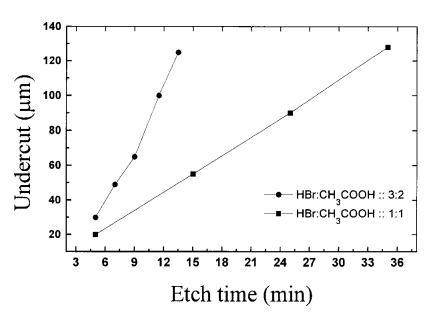Realization of low-cost and reliable packaging techniques to couple the optical fiber with the photodetector has become a criticalarea of research today. In the present work, we have developed a simple technique to automatically align the fiber with the detectorby micromachining the InP substrate ~used for fabricating the p-i-n detector! and using the resulting V-groove for accuratepositioning of the fiber. A masking material has been deposited on the back surface of the wafer and patterned by photolithographyto open a window exactly aligned to the p-i-n detector realized on the top surface. InP has been etched anisotropically through thiswindow to a depth of more than 350 mm. This has resulted in a V-groove through which the fiber has been inserted and held inposition. Three different etch mask materials viz. Ti, Cr, and SiN have been tried and their suitability to withstand such long timeetching has been investigated. HCl:H3PO4 and HBr:CH3COOH etch solutions have been used to etch InP. It has been found thatwhile the choice of the etching solution determines the angle of the V-groove as well as the surface finish, the mask materialdictates the amount of undercut. Ti as the mask material with HBr:CH3COOH etch solution has been found to give the best resultsfor this particular application.
One of the most challenging tasks in the packaging of p-i-n photodetectors is the coupling of the optical fiber to the detector. Asboth the detector and the fiber are of very small dimensions, preciseand accurate alignment is very critical. Today, in most cases, this isdone by the time consuming and costly active alignment technique,which involves adjusting each fiber individually, while the diode isoperating, for maximum response and fixing it. Thus, there is a needto develop passive self-alignment techniques that are less time consuming, more cost-effective, and at the same time, reliable and reasonably efficient. As micromachining of semiconductor materials isknown to be precise with excellent dimensional control, it is wellsuited for realizing precision microstructures, which can then beused for passive fiber self-alignment. Anisotropic wet chemicaletching of single crystal silicon resulting from the differential etchrate of its crystallographic planes is a well-established and populartechnique.1 This has been used to fabricate a variety of high precision passive microstructures, which were then used for holding thefiber and directing the light. However, since a majority of the opticaldevices are made of direct bandgap compound semiconductor materials like InGaAs and InP, the devices have to be mounted on themicromachined silicon wafer by flip-chip technique for fiberalignment.
As mentioned above, there is a lot of published literature onrealization of V-grooves in InP. However, most of the experimentaldata has been published for etch depths less than 25 mm. Klockenbrink et al.2 discuss V-grooves etched to depth of 120 mm, but theirwork is restricted to HCl:H3PO4 etchant. In the present work, theV-groove etching is being carried out for a particular applicationwhich requires etch depths greater than 350 mm. This requires etching for a much longer period of time. The etch masks now play amore significant role, as severe undercuts may result due to theinteraction of the etchant with the masking material. To optimize theprocess, the best combination of etchant and etch mask suited forthis long time etching must therefore be chosen. With this objective,we have carried out wet chemical, orientation dependent etching (ODE) of InP~100! substrate using Ti, Cr, and plasma-depositedsilicon nitride etch masks. The effect of these mask materials on theextent of undercut has also been studied. HCl:H3PO4 as well asHBr:CH3COOH etch systems have been used to study the sidewallangle as well as the surface finish after etching. The best combination of etchant and etch mask is then identified based on the extentof the undercut, surface smoothness and angle of the V-groove.

Fig1
With this idea, the fabrication of the V-grooves on InP~100!substrate has been carried out. The four important aspects of thesuccessful realization of the V-groove are (i) the crystallographicperfection of the substrate, (ii) precise aligning of the mask patternin particular direction, (iii) good adhesion of the mask materialwith the substrate, and (iv) the particular etch solution used to etchInP. These factors affect the actual shape of the V-groove, the degree of undercut upon etching, as well as the surface smoothness ofthe exposed facets, all of which are crucial for the actual alignmentof the optical fiber with the detector. In the present work, differentetch mask materials as well as various etch solutions have been usedto optimize the fabrication of V-grooves.
Of the three etch masks studied in the present work, titanium isthe most effective showing minimum undercut and well-defined facets on etching. A possible reason of this is better adhesion of titanium to InP.
上一篇: Al2O3层的蚀刻选择性和钝化性
下一篇: GaN 的晶体湿法化学蚀刻